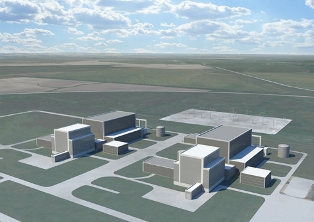NRG Withdraws From Texas Nuclear Project
The future development of South Texas Project (STP) units 3 and 4 looks unlikely after majority shareholder NRG Energy announced that it will write down its investments so far in the project and make no further investment.
The project to construct two Advanced Boiling Water Reactors (ABWRs) at STP is being developed by Nuclear Innovation North America (Nina) – jointly owned by NRG Energy and Toshiba. It had been considered among the leading new build projects in America, and was one of the few that had survived both the financial crisis and the new availability of cheap natural gas.
NRG noted that it does not have the unilateral right to cancel the project, only the right to terminate its participation in it. The company said, “while it will cooperate with and support its current partners and any prospective future partners in attempting to develop STP 3 and 4 successfully,” it will not invest additional capital in the STP effort. NRG will write down its investment so far in STP units 3 and 4 and record a first-quarter 2011 pre-tax charge of some $481 million, for “the impairment of all of the net assets of Nina.” The write down consists of $331 million of Nina net assets funded by NRG, together with $150 million of net investment contributed by Toshiba.
The company blamed the move on the continuing emergency at the tsunami-hit Fukushima Daiichi plant in Japan and the subsequent safety review by the US Nuclear Regulatory Commission (NRC) that could lead to modified design requirements for the STP units. Although an engineering, procurement and construction (EPC) contract for the project has already been awarded, it is impossible to finalize a price without the final design, said NRG. Furthermore, discussions about power purchasing agreements are “pointless” without a firm price for the new units. In addition, NRG said that planned Japanese financial participation in the project is “now significantly in doubt.”
David Crane, chairman of Nina and CEO of NRG, said: “The tragic nuclear incident in Japan has introduced multiple uncertainties around new nuclear development in the United States which have had the effect of dramatically reducing the probability that STP 3 and 4 can be successfully developed in a timely fashion.”

He added, “We continue to believe both in the absolute necessity of a US nuclear renaissance and that STP 3 and 4 is the best new nuclear development project in the country bar none. However, the extraordinary challenges facing US nuclear development in the present circumstance and the very considerable financial resources expended by NRG on the project over the past five years make it impossible for us to justify to our shareholders any further financial participation in the development of the STP project.”
Last month, Nina announced that development of the new STP units had been slowed in response to regulatory uncertainty following recent events at Fukushima Daiichi. At that time, the company said that it was reducing the scope of development of the units “to allow time for the US NRC and other nuclear stakeholders to assess the lessons that can be learned from the events in Japan.” For the time being, it had said, work related to development of the two new units would be limited to licensing and securing a federal loan guarantee for the project.
Nina will continue work on securing a combined construction and operating licence (COL) from the NRC and on obtaining a loan guarantee from the US Department of Energy, as these “two assets are absolutely essential to the success of any future project development.” It noted that Toshiba will be responsible for funding ongoing costs to continue the licensing process. NRG said that it expects to incur one-time costs, related to a contribution to Nina, of up to $20 million.
Toshiba received a 12% stake in Nina, in return for a $300 million investment over six years. Half of this investment is to support the proposed new ABWRs at STP through Nina Investments Holdings. The other half is for new ABWR projects in North America with other potential partners. Nina holds a 92.4% stake in the project to build STP Units 3 and 4, with the remaining 7.6% held by CPS Energy (which owns 40% of the existing STP units). The project had originally been a 50-50 venture between Nina and CPS, but CPS decided to withdraw from the project altogether. However, in February 2010 an agreement was reached under which CPS would retain a small stake. CPS recently announced that it was indefinitely suspending all discussions with NRG regarding a power purchase agreement for electricity from the planned new STP units.
In May 2010, Japanese utility Tokyo Electric Power Company (Tepco) – owner of the stricken Fukushima Daiichi plant – agreed to invest $155 million for a 9% stake in the project to construct the new STP units, with an option to later increase this stake to some 18% for an additional $125 million within about one year. Tepco has been providing technical consulting services to the project since March 2007. The extent of the company’s future involvement in the STP project is uncertain.
The South Texas Project currently consists of two pressurized water reactors (PWRs), which together produce some 2700 MWe. The reactors were brought online in August 1988 and June 1989. The facility is operated by STPNOC and owned by NRG Texas (44%), CPS Energy (40%) and Austin Energy (16%).
Although the COL for STP is not anticipated until 2012, an engineering, procurement and construction (EPC) contract for the project has been awarded to a consortium of the Shaw Group and Toshiba America Nuclear Energy Corporation, and an order for one of the reactor pressure vessels has already been placed with Japanese engineering company IHI. Construction of the two new ABWRs at STP was expected to begin next year, with the first 1358 MWe unit coming online in 2016 and the second in 2017.
Researched and written by World Nuclear News

